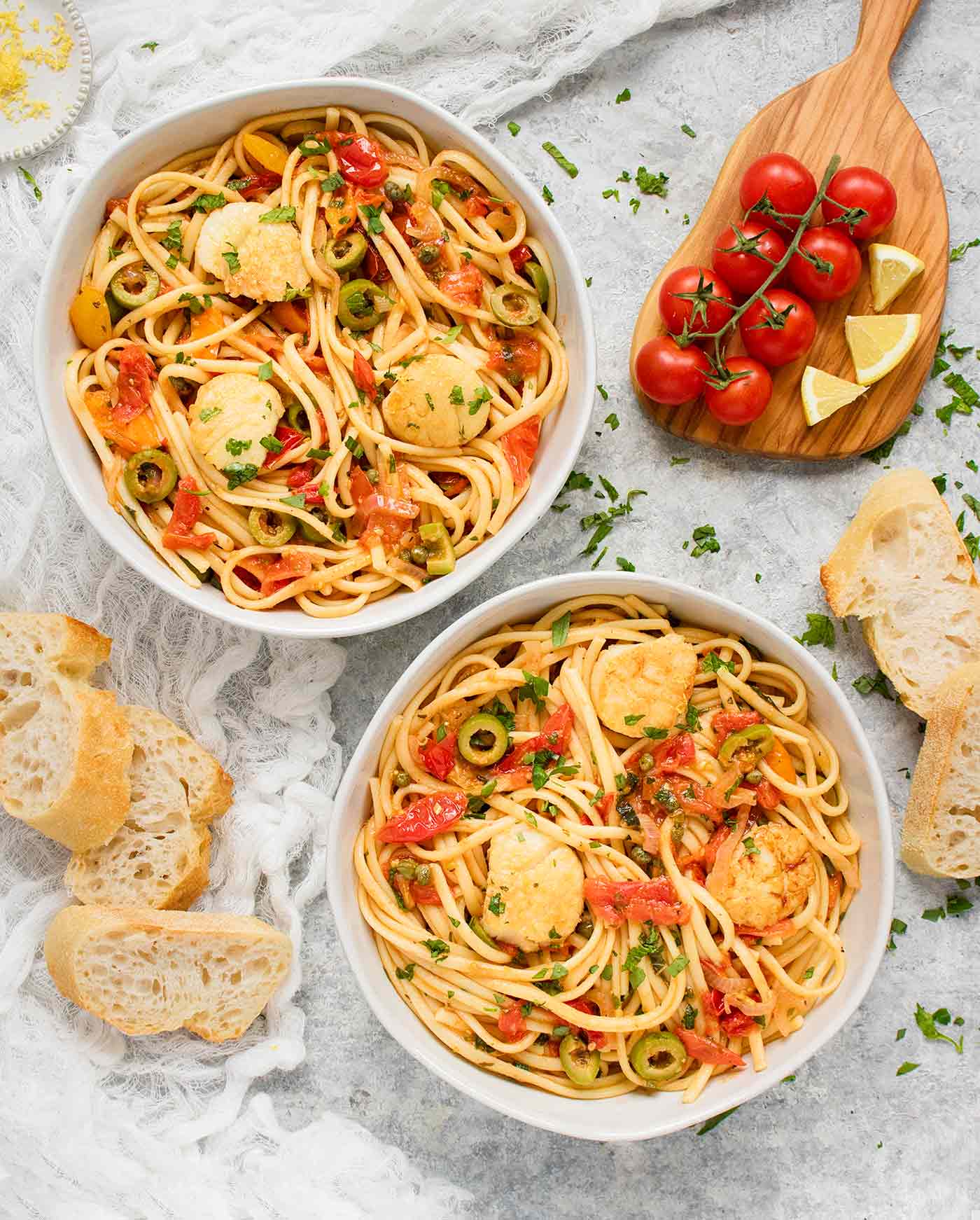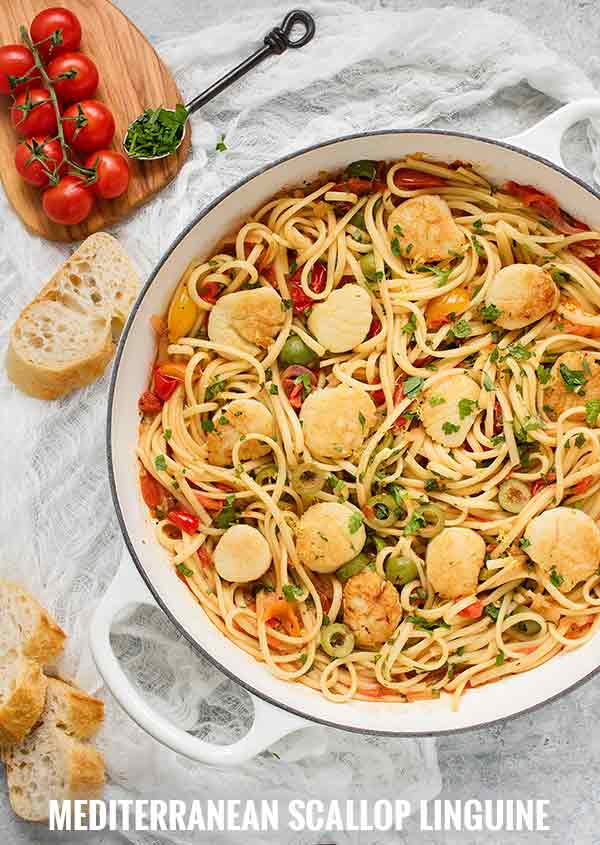The best Mediterranean flavors come together in this pasta and sea scallops dish. Start with a jammy tomato saute, add flavor-boosting olives, capers, and Greek seasonings, and you have a scrumptious meal of scallop linguine.

It’s officially spring, and I’m officially getting antsy for fresh, homegrown tomatoes. But, I’m still a few months away from the first of those dreamy, magical orbs plucked right from the plant, so I had no choice but crack and scoop up some cherry tomatoes at Whole Foods (at least they were locally grown).
Grocery stores standard tomatoes are decidedly iffy, but cherry tomatoes of any season have their charms: they cook down — skins, seeds, and all — into an irresistibly jammy sauce that enrobes the linguine in its sweet savoriness. (Homegrown will be positively swoon-worthy.)
The dish then swerves from its Italian-inspired beginnings towards a Greek finish, with Mediterranean seasonings, olives, capers, and treasures from the sea.

There’s nothing quite like a perfectly seared sea (or diver) scallop with a glistening layer of caramelization. If you’ve never cooked scallops before, or have had mixed success, here are some tips to you along.
What’s the difference between a dry scallop and a wet scallop?
- The key to searing scallops actually starts at the store: choose the right type … if you can. Why? Because dry scallops sear easily, whereas wet scallops might or might not. The scallops in the photos on this page are wet, and do not feature the nice, deep sear you see in glossy magazines.
- A dry scallop — sometimes called “natural” — is a scallop that is not treated after harvesting.
- A wet scallop, on the other hand, is a scallop that has been treated with a brine of phosphates that acts as a preservative, and then is flash-frozen for transport. The brine suffuses the scallop with liquid, which, later, makes it difficult to get that browning sear on the scallop’s outer surface.
- This treatment is usually listed on the packaging, but you can often just visually spot the difference between dry and wet scallops: dry scallops can have a very light tan or rosy appearance. Wet scallops are white, and if they were frozen in a pool of the brine, everything will be slightly milky.
- Dry scallops are often available only near their harvesting site, but some specialty suppliers do freeze and ship dry scallops overnight. I’m a landlocked Midwesterner, so my scallop choices are extremely limited. My one source for dry scallops dried up, so to speak, when they relocated their store to a neighborhood across town. If I’m organized enough, I’m happy to hike over there on a Sunday morning, but that’s a big “if,” lol. Usually, I’m stuck with grocery store options, which are always wet.
- Dry scallops are noticeably tastier, so if you have access to dry, go for it!
How to Sear Scallops
- Thaw your scallops, if frozen, and then rinse and pat dry. Wet scallops will, unfortunately, retain a good bit of moisture no matter what you do because of the phosphate solution, giving them an extra rinse (or a lemon-water soak) can sometimes help. Let the scallops rest for 5 minutes on paper towels, to absorb as much water as possible. Season with salt.
- Remove the rectangular side muscle by peeling it away and discarding.
- Heat vegetable oil in a large skillet over high or medium/high heat, just until the oil begins to smoke.
- Add the scallops in a single layer, leaving a couple of inches in between.
- Let them cook undisturbed for 2 minutes. Use a thin metal spatula lift one up to check the bottom. Dry scallops will have browned; wet may or may not have.
- Gently flip the scallops and cook on the other side for another minute-and-a-half or so. Wet or dry, fully-cooked scallops will be opaque, but not rubbery.
- Remove to a plate and tent with foil to hold. Or, for this recipe, transfer the scallops directly to the linguine.

My favorite flavor layer in this dish is definitely the jammy tomatoes, but stirring in the briny olives and capers adds a lovely contrast and salty depth.
Best of all, Mediterranean Scallop Linguine is a reasonable weeknight meal, time-wise, and has fewer than 10 ingredients. Enjoy the tender scallops, the twirly linguine, and the beautifully seasoned tomato base!
Karen xo
Mediterranean Scallop Linguine
Ingredients
- 12 ounces linguine
- olive oil
- 1 pound cherry tomatoes sliced in half or quarters
- 2 cloves garlic minced
- 1 teaspoon Greek herb blend
- 12 green olives* sliced in half or thirds
- 1 tablespoon non-pareil capers drained
- 1 pound sea scallops side muscles removed
- Fresh cilantro minced
Instructions
- Prepare the linguine according to package directions. Drain, and set aside.
- While the pasta cooks, in a large skillet or saute pan, pour a thin layer of olive oil to cover the bottom. Heat over medium until shimmering, and then add the tomatoes. Cook until the tomatoes are soft, almost jammy.
- Add the garlic, Greek herbs, olives, and capers, and stir well. The sauce should be rich and tomatoey.
- Add the pasta and toss with the sauce.
- In another skill, heat about a tablespoon of olive oil over medium/medium-high until shimmering. Pat the sea scallops dry with a paper towel, and add to the pan. Let the scallops cook on one side until they begin to brown**. Flip and sear the other side.
- Transfer the scallops to the pasta, garnish the dish with cilantro, and serve.
Notes
Nutrition
Pin Mediterranean Scallop Linguine recipe for later:
Pinterest fans, if you’d like to save this recipe for later, use these images (or any image above) to pin to your boards (they’re small here, but thanks to the magic of the interwebs, they’ll be full size when you pin them). Thanks for sharing, and most of all, thank you so much for reading this post! Blogging wouldn’t be any fun without you!



